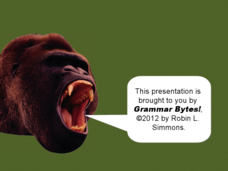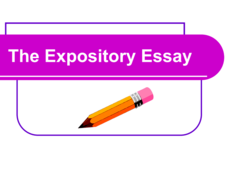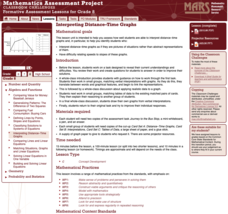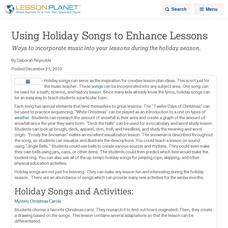Curated OER
Digging Up Dino Data
Third graders use the Internet to research a specific dinosaur. They work in pairs and individually to browse dinosaur websites, take notes on pertinent information, write, edit and illustrate reports. They post their work.
Curated OER
Documenting Child Labor in Nepal
Fourth graders, using Apple's iMovie, create a digital documentary to raise awareness about the existing child labor in Nepal.
Curated OER
Earth Day Number Sense
Elementary schoolers count and order objects using numbers 1-300. They bring recyclable items from home. Young scholars group the items, skip count by 2's, 3's, and 5's, and arrange the items on a number line. Recyclable plastic bags are...
Curated OER
Grammar Bytes: Adjectives and Adverbs
Using a format similar to what students may see on standardized tests, this presentation discusses the proper use of adjectives and adverbs. The examples focus on some of the most common errors, including the use of the words poorly and...
Curated OER
The Rest Cure: Gender in Medicine and Literature
Read and discuss "The Yellow Wall-Paper" and the gender issues that the story brings up. Use articles from the time period to analyze, complete with specific discussion questions. After two days, scholars write an essay based on topics...
jc-schools
The Expository Essay
Did you ever create an awesome graphic organizer only to find that your class was completely baffled by how to use it? This resource not only provides you with a great graphic organizer for a standard five-paragraph essay, but also...
ReadWriteThink
Literature Circles: Getting Started
Make reading more enjoyable and interactive with literature circles! Here you'll find detailed lessons to begin the literature circle process. Ten lessons introduce each role learners take on. Literature circle roles include...
Channel Islands Film
Island Rotation: Lesson Plan 3
How far have California's Channel islands moved? What was the rate of this movement? Class members first examine data that shows the age of the Hawaiian island chain and the average speed of the Pacific Plate. They then watch West of the...
Science 4 Inquiry
Trick or Science: Catching the Light
Your class might be surprised to learn that mirrors have been around since the first century AD! Young scientists explore reflection and refraction of light through a series of challenges. They use this knowledge to design their own...
Curated OER
My Childhood Portrait
Students practice descriptive writing by viewing auto-portraits of young children. In this art analysis lesson, students examine an auto-portrait of their teacher as a young child and ask him/her questions about their youth. Students...
Curated OER
Vocabulary Unit 1-4
In this Vocabulary worksheet, students complete four parts on four pages by matching vocabulary terms in a variety of activities.
Curated OER
Circle of Pong
Students, in groups, use given materials to devise a way to deposit a ping-pong ball into a paper cup that is located in the middle of a 6-foot diameter circle, while standing outside the circle.
Curated OER
Postmark U.S.A.
Students identify and collect postmarks from across the United States. They develop a list of ways to collect postmarks, display the postmarks on a large U.S. map, and find the exact location using MapQuest.
San José State University
Semicolons
This worksheet provides a good description of when to use a semicolon, followed by 6 sentences to practice inserting punctuation. A key is provided.
Mathematics Assessment Project
Interpreting Distance–Time Graphs
Pre-algebra protégés critique a graph depicting Tom's trip to the bus stop. They work together to match descriptive cards to distance-time graph cards and data table cards, all of which are provided for you so you can make copies for...
Park City Historical Society & Museum
Oral History Interview Questions Worksheet
What is an oral history interview? What goes into the planning and what should be said? Why is it important that we know and learn from oral history? This is an excellent learning exercise to support your young historians as they conduct...
Curated OER
Grow an Alum Crystal
What an exciting lab experiment to conduct with your high school chemistry class! Crystals are formed naturally in the environment. However, allow your blossoming chemists to create their own unique crystals using alum and water. You may...
Curated OER
Narrative Writing
Fifth graders study narrative writing. In this language arts lesson, 5th graders review how an author uses vivid verbs, imagery, and adjectives to capture reader's attention. Students explore literary devices of foreshadowing, flashback...
Curated OER
You Wouldn't Understand...It's a Slang Thang
Fourth graders study a decade in history through its slang. They analyze a slang dictionary from the 1920's and read a primary source letter making use of the slang. They decipher the language and compare and contrast 1920's language...
Curated OER
Using Memoirs to Open Doors to Research
Interesting memoirs can be a springboard into some very enjoyable research assignments.
Curated OER
Who Am I? (Intermediate Grades)
Students write "Guess Who?" poems in a descriptive manner. They listen to the poems as they are read aloud and try to guess who the poem belongs to.
Curated OER
Learning Scientific Coral Terminology
Learners explore properties of coral. In this scientific observation lesson plan, students investigate properties and characteristics of coral. Learners write statements describing the coral using observation words.
Curated OER
Monster Voices
Students create stories based upon the techniques of author Maurice Sendak in Where the Wild Things Are. They use a word processing program and the Apple software program GarageBand to create new voices for the story. This lesson plan...

























